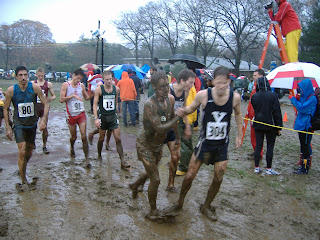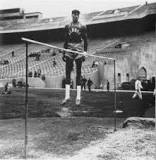They Tried But Couldn’t Catch the Unsurpassed
Book Review
By Paul O’Shea
Catch Me If You Can
Filbert Bayi with Myles Schrag
257 pages, $19.95, Soulstice Publishing
Where is the next Filbert Bayi? It’s been years since going coast to coast in high value
competitions was a tactic deployed in the middle distances. Where is now the courageous
competitor so committed to a fast pace, starting line to finishing line, that he or she is literally
unsurpassed?
Perhaps the most successful front running was a virtuoso performance and world record time
forever entwined: Filbert Bayi ran fifteen hundred meters in 3:32.2 at the 1974 Commonwealth
Games. Almost a half century later, a photo of the finish graces the cover of Bayi’s splendid
new autobiography, Catch Me If You Can: Revolutionizing My Sport, Breaking World Records,
and Creating a Legacy for Tanzania.
Those of us following the world of athletics will be pressed to recall another athlete so
successfully issuing the Catch Me challenge. Instead, we have earnest, jostling runners clumped
together with a lap or so to go, seconds melting away, all confident in their closer capacity.
Bayi ran what some called the greatest fifteen hundred meter race of all time, that February
day in Christchurch, New Zealand. He deployed a simple strategy. Run away. Don’t let the
others, even those world class, beat you. Spend all of your energy in the first fifteen hundred
or sixteen hundred meters (if a mile), such that your pursuers will be like the youngster crying
“Shane, come back.”
Years later the English writer Pat Butcher, criticizing Roger Bannister’s sub-four minute mile as
an unworthy, paced event said in The Guardian: “The defining moment of 20 th -century middle-
distance running didn’t occur in Oxford on May 6, l954, it came in the Queen Elizabeth II
Stadium in Christchurch, New Zealand, on February 2, 1974. And the genius to who we should
all be paying homage is not Roger Bannister but Filbert Bayi of Tanzania.
“Bayi’s performance is an indictment of every middle distance runner who thinks that they have
to be paced to turn in a decent time. The film of his run should be compulsory viewing for every
aspiring middle-distance runner.”
At the starting line were three Olympic medalists: Rod Dixon, Ben Jipcho and Mike Boit, and
Brendan Foster, and John Walker and Filbert Bayi, both in the early twenties. Bayi was off at
the gun and had twenty meters on the field at 800. Walker clawed back some of the gap in the
third quarter, but the Tanzanian rallied and won going away. Roger Bannister called it the
greatest race he had ever seen.
Filbert Bayi was born in the Rift Valley of Tanzania in 1953. His early years were spent doing
family chores, as a herder on the family farm, chasing rabbits for exercise. He played the usual
games, but his aerobic capacity pointed to competing well in distance running events, including
regional championships in l964.
Two years later progress slowed after he contracted tuberculosis. Then, with good grades and
an interest in military service, the seventeen-year-old joined the Tanzanian army in 1970. He
liked the hard work and discipline required of a soldier, and the opportunity to train as an
athlete. In one of his first races he finished second in a half mile with 1:55.
His breakthrough came in 1972 at the Munich Olympic Games. With personal bests of 3:45.6 in
the 1500 and 8:55 in the steeplechase, Bayi was thought by the Tanzanian authorities to have
the best opportunity to reach an event’s final. Instead, the inexperienced nineteen-year-old
attended a masterclass given by competitors.
“These were experienced racers who had trained four years for their big moment, and they
weren’t giving an inch,” he writes. Even though he ran fourteen seconds faster than his
qualifying race, the Tanzanian finished ninth in his heat. All of this came while the world and the
Games were suffering the effects of the Palestinian militant massacre which killed eleven Israeli
athletes.
Angered by his inability to handle the pace, tactics, and calisthenics of the steeplechase, he
returned a week later to run the fifteen hundred.
“Unfortunately, I got knocked around again. I got boxed in early and with that many
competitors in less than four laps it’s difficult to escape when you’re stuck.” He was a non-
qualifying sixth.
“When I got home, I vowed to run from the front and never put myself in the position to get
spiked or where I couldn’t fully expend my energy by the end of the race.
“Embracing the role of pacesetter, as it turned out, would change my life forever.”
In l973 he defeated Kip Keino at the African Games. Later that year he ran the third fastest
fifteen hundred meters in history.
.
Thirty-six thousand fans were on hand in Kingston, Jamaica’s national stadium in 1975 to see
another display of Bayi front running. At halfway in The Dream Mile, Bayi held a comfortable
lead, but Eamon Coghlan and Marty Liquori decided the Tanzanian could be vulnerable. But as
soon as Coghlan attempted to inch ahead at the three-quarter mark, Bayi took off and
destroyed the two Villanovans. Jim Ryun’s world mile record fell by a tenth.
In l980 he finished second in the Moscow Olympic steeplechase.
When his career ended, Bayi and his wife embarked on a mission to help educate young
Tanzanians. They started modestly in 1996. Using their own funds they began using the garage
adjacent to their home. Seven primary grade students comprised that first class. Gradually they
attracted so many students that they saw possibilities in expansion. The Bayis acquired a fifty-
acre plot and built schools which now serve more than 1200 nursery, primary and second
students on two campuses. After a few years they established the Filbert Bayi Foundation.
Bayi’s Catch Me If You Can writing cohort is Myles Schrag, author of Diamond in the Desert: The
Story of the Connie Mack World Series in Farmington, New Mexico.
The book launching was at the 2022 Commonwealth Games, and the blurb providers are world
ranked: Seb Coe, Edwin Moses, Rod Dixon, Eamon Coghlan, broadcaster Larry Rawson. Amby
Burfoot advises: “This is a book that will be enjoyed by any running or track fan who
appreciates how the back story contributes to the gold medal.”
Catch Me is a rare opportunity to catch up with one of our sport’s legendary figures.
August 15, 2022
Paul O’Shea writes about running from his home in Fairfax, Virginia
From: George Brose
Here's a little add on story about Filbert Bayi running at the University of Oklahoma. I got this straight from then coach J.D. Martin a few years ago.
Here's a Walk In story from J.D. Martin who coached over 35 years at U. of Oklahoma.
JULY 2005
Last year after picking up the current OU Track and Field media guide, I was browsing through the list of former letterwinners. Up came the name of Filbert Bayi in the late 70's. Filbert Bayi was one of the premier milers in the world and had once held the world record in that event. Then I see that he earned a letter at OU years after setting the record. This had to be an interesting story and certainly J.D. was the man to provide background. How did he get to OU, how many Mercedes did J.D. have to buy him, how's come he didn't retake the mile record with J.D.'s coaching? Like any newsman, you go to the source. So here's J.D.'s reply.
George, here's the poop on Filbert.
It starts with me hiring a distance coach from Eastern New Mexico named Bill Silverberg.
He had a reputation of getting Kenyans and other foreign runners.
Anyway, after he was with me for awhile he asked what travel agency we used to fly kids to school. I told him none, as that is a NCAA violation. He wanted to know how I expected him to bring athletes here from Kenya or Tanzania. That was my first clue that he had his own ways of playing the game and he scared me to death.
Later that year Kenyan's began showing up on campus. Most could not get into school
and were sent along to JR. Colleges. One young 18 year old ran for a couple of years but didn't make much of an impact.
But one day out of the blue and a surprise to Silverberg, Filbert walked into our office.
He knew Silverberg and had heard that he was recruiting for us. He just decided to
come over and see if he could go to school and run for us. All legit.
He ran cross country for us but had some injury problems and was never able to perform
up to his abilities. After one semester he decided to transfer to UTEP where most of his
buddies were and the climate was more like home.
One day later I get a call from a local travel agency wanting to know when we were going to pay the bill for the flights from Africa......(not Filbert)
After getting up off the floor Silverberg and I had a little discussion about him working somewhere else and told him he had a large bill at the travel agency.
He moved on and I don't know if the bill was ever paid.
Filbert was as great person. It is a shame he didn't stay longer and get healthy.
That is the Filbert Bayi story.
Some of you distance runners may remember Bill Silverberg as a pretty good steeplechaser when he ran at Kansas.





















